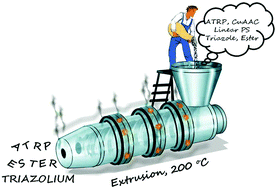ATRP-based polymers with modular ligation points under thermal and thermomechanical stress†
Abstract
Linear polystyrenes carrying a mid-chain triazole, esters as well as terminal secondary bromines functionalities were synthesized via activators regenerated by electron transfer (ARGET) atom transfer radical polymerization (ATRP) using a bifunctional triazole containing initiator (3.8 kDa ≤ Mn,SEC ≤ 125 kDa, 1.08 ≤ Đ ≤ 1.19) with the aim of understanding their behavior under thermal and thermomechanical stress. As reference materials – isolating the influence of individual functional groups – three polystyrene homopolymers carrying an ω-bromine chain-end functionality, α,ω-ester-bromine functionalities as well as α,ω-dibromine/mid-chain ester functionalities (2 kDa ≤ Mn,SEC ≤ 39 kDa, 1.06 ≤ Đ ≤ 1.08) were prepared via ARGET ATRP. Furthermore, a well-defined triazole mid-chain functionalized block homopolymer, i.e. polystyrene-b-polystyrene (PS-b-PS, Mn,SEC = 4.4 kDa, Đ = 1.08), was synthesized via a combination of ARGET ATRP and copper(I)-catalyzed azide–alkyne cycloaddition (CuAAC) as a reference material. Reference polymers without bromine and with ester/triazole functionalities were additionally investigated. Thermomechanical stress was applied to the polymers via small scale extrusion as well as a rheological assessment (G′(t), G′′(t)) under processing conditions. The thermally challenged polymers were analyzed by size-exclusion chromatography (SEC), matrix-assisted laser desorption/ionization time-of-flight mass spectrometry (MALDI-ToF-MS), proton nuclear magnetic resonance (1H NMR) and X-ray photoelectron spectroscopy (XPS) to arrive at a detailed image of the degradation susceptibility of individual functional groups, especially esters, bromines and triazole functions. The findings indicate an enhanced degradation of ATRP polymers via an accelerated ester cleavage due to HBr release at high temperatures accompanied by a concomitant molecular weight increase due to the formation of triazolium salts via the reaction of triazole units with bromine terminal chain ends.


 Please wait while we load your content...
Please wait while we load your content...